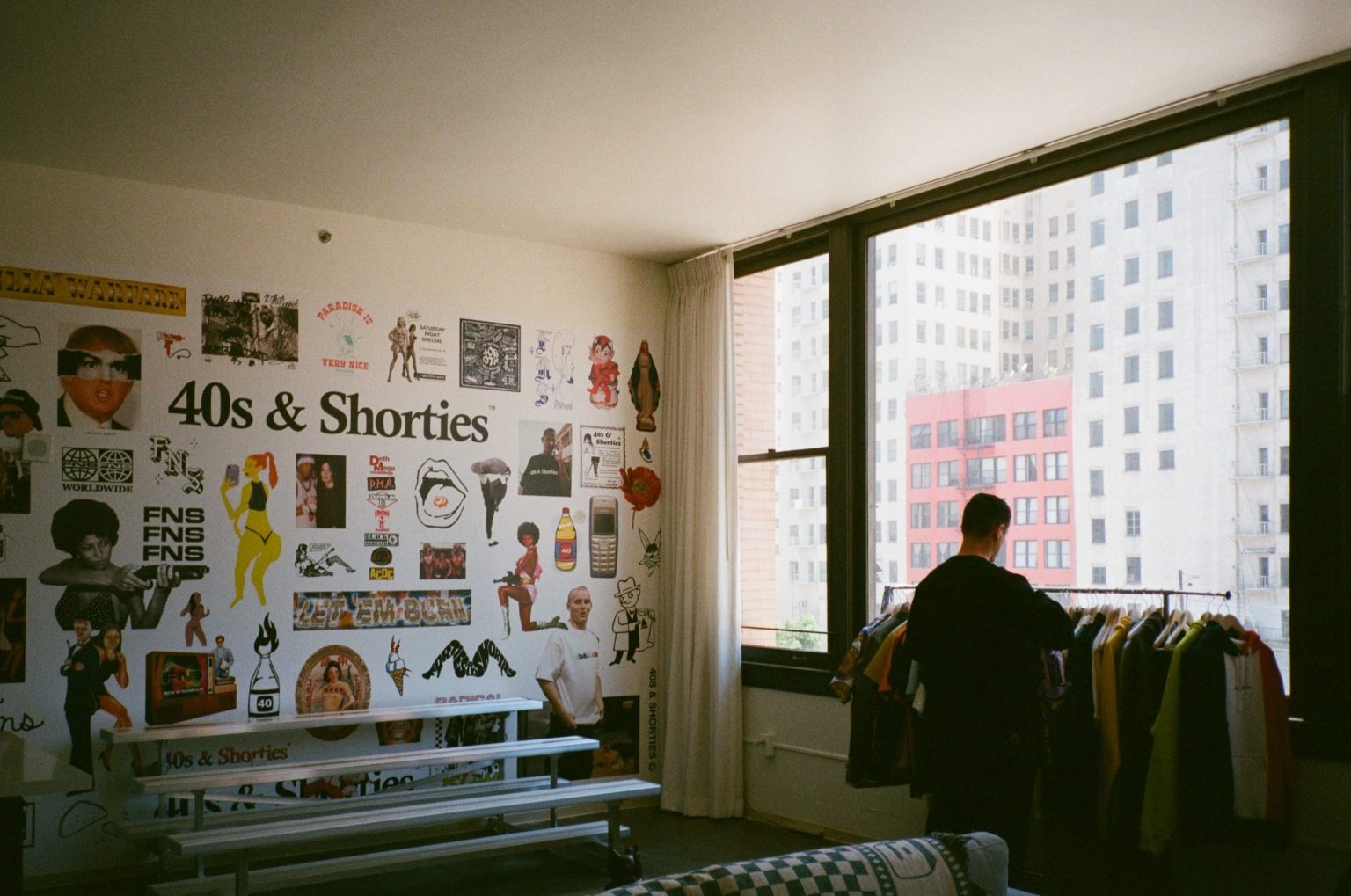At MAEKAN, the story defines the medium. Some stories function best as written text, others hope to capture the emotion through an intimate audio experience. In cases such as this audio story, the transcripts we provide are done to the best of our ability through AI transcription services and human transcribers. We try our best, but this may contain small errors or non-traditional sentence structure. The imperfection of humans is what makes us perfect.
Adem Niazi: When we started this shit it was just —
Drewbyrd: Some fun shit. But it was an idea that had something, you know, because it was just stuff that was funny to us and it was nostalgic to us.
Adem: It’s basically just our childhood kind of thing, just us growing up. So it’s like you take that idea you can apply it to fucking anything whether it be socks, accessories, or cut-and-sew. It mutated into this lifestyle brand. When we came out of the gate with the socks, they did alright. Once they sold out we were like, “Fuck, do we make a second season?” That was the moment that we made that decision. We were like, “Holy fuck.”
Charis Poon: You’re listening to Adem Niazi and Drewbyrd talk about how their streetwear and lifestyle brand, 40s and Shorties, got off the ground. Adem is the one dropping f-bombs. This is a good time to mention that this episode is totally unbeeped, so please be advised. 40s and Shorties was founded in L.A. in 2013 by Adem, Drew, and Ryan De La Cruz. The friends started off making socks, moved on to producing printables, and progressed from there to cut-and-sew. What started for laughs grew legs and evolved into something sustainable.
Charis: Do you think there’s a certain kind of passion that comes when you’re just starting a side project and you don’t know yet if it’s going to be successful?
Adem: Absolutely. For me personally, not knowing how you’re going to make your next check and you have no idea what the next week, the next month is going to look like, it’s like equal parts excitement and fear. For me it’s like that drive, at least at the beginning, it was like this driving force behind us doing everything. It gives you that energy all the time to be like, “Alright, I’m going to fucking do 800 jobs. He’s going to do 800 jobs.” And it’s that sort of weird fear of uncertainty in the beginning, if that makes sense.
Charis: So now that 40s is established and this is your full time, does it lose some of that charm, does that lose some of that drive?
Adem: That’s actually a really good question.
Drewbyrd: I mean, yes and no. For me personally, I still do music, I still DJ. Before 40s and Shorties that’s all I really knew was just DJing, going on the road, and making beats and stuff. This kind of came along and I just had to learn everything on the way, but it’s still very fun. We’re a very small percentage where we can just work with our friends and just make a product and put it out there into the world.
Adem: I think to answer your question, it’s yes and no. It’s not so much to the point where we’re like a massive brand or anything like that, we’ve got a giant squad or like mad corporate. We’re not that by any means. As any company grows, it doesn’t matter if it’s in this industry or the next one, right, and the people that have founded it grow with it, you begin to evolve as well. I would say that the heart and soul of 40s is still really raw, is still fucking like us, is still based in the shit we grew up on and whatnot. But you can’t help but absorb certain things like payroll and fucking insurance, cease and desists, and shit like that which tarnishes that shiny, awesome, raw thing that you started.
So it’s like five years down the road, what’s that percentage going to be like? But to keep you driving forward, you’ve got to make sure it’s never lopsided to where it feels more work than it is heart. That threshold at absolute most needs to remain maybe fifty-fifty. But for us right now, it’s like, it’s fun, man. And I mean it’s a shit ton of stress, but you get to be your own boss. It’s the one real attribute out of all of this that is great.
Charis: Would that be the signal to you that things were tipping too much over to the other side if you felt, “I’m actually doing this for someone else,” like someone else is telling me what to do, whether that someone is another brand or your fans and that would signal to you, “Hey, I’m not enjoying this anymore.”
Adem: It depends on the degree, because a good word for that is compromise. And we have to compromise very regularly, right. When we came out of the gate we just did whatever the fuck we wanted to do on socks. Once we made that transition into printed goods, you quote unquote can’t do certain pieces of art. One, it’s not going to get received in the same way, because our background is like U.S.A., West Coast. It doesn’t translate the same way, in like, you know, this part of the world.
Plus, the insanity of graphics, the crazy kind of content that I would like to put on tees isn’t for everybody, you know what I mean. So it’s like you’re going to have those moments, you’re going to have those opportunities, either getting a new account or doing a certain kind of collaboration or needing to do a certain kind of design. Those moments of compromise, they kind of act as what you’re talking about, but I don’t think it’s so much to the point where we feel like this shit’s not ours.
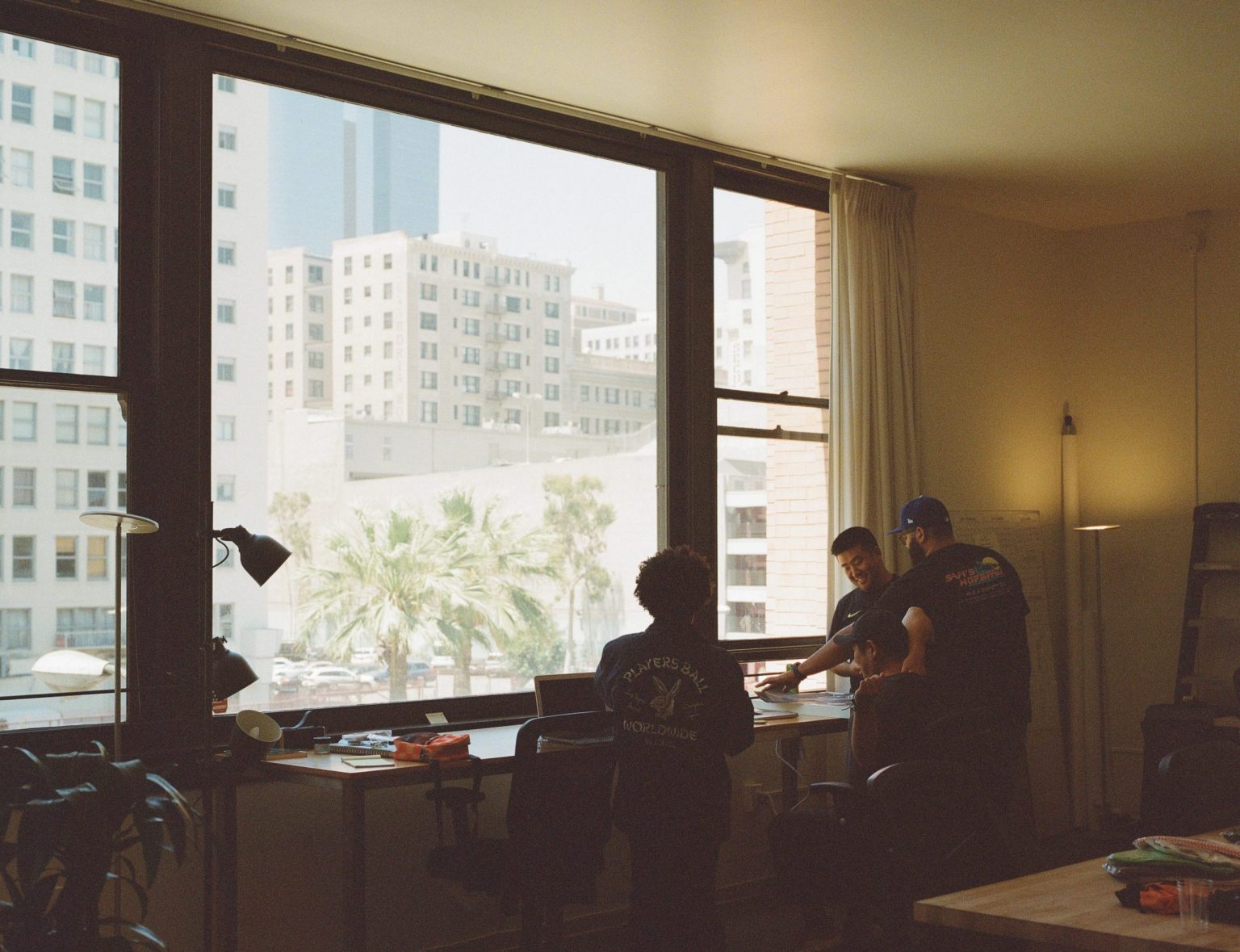
Part of the 40s and Shorties team at their Los Angeles office.

Entrance to the office.
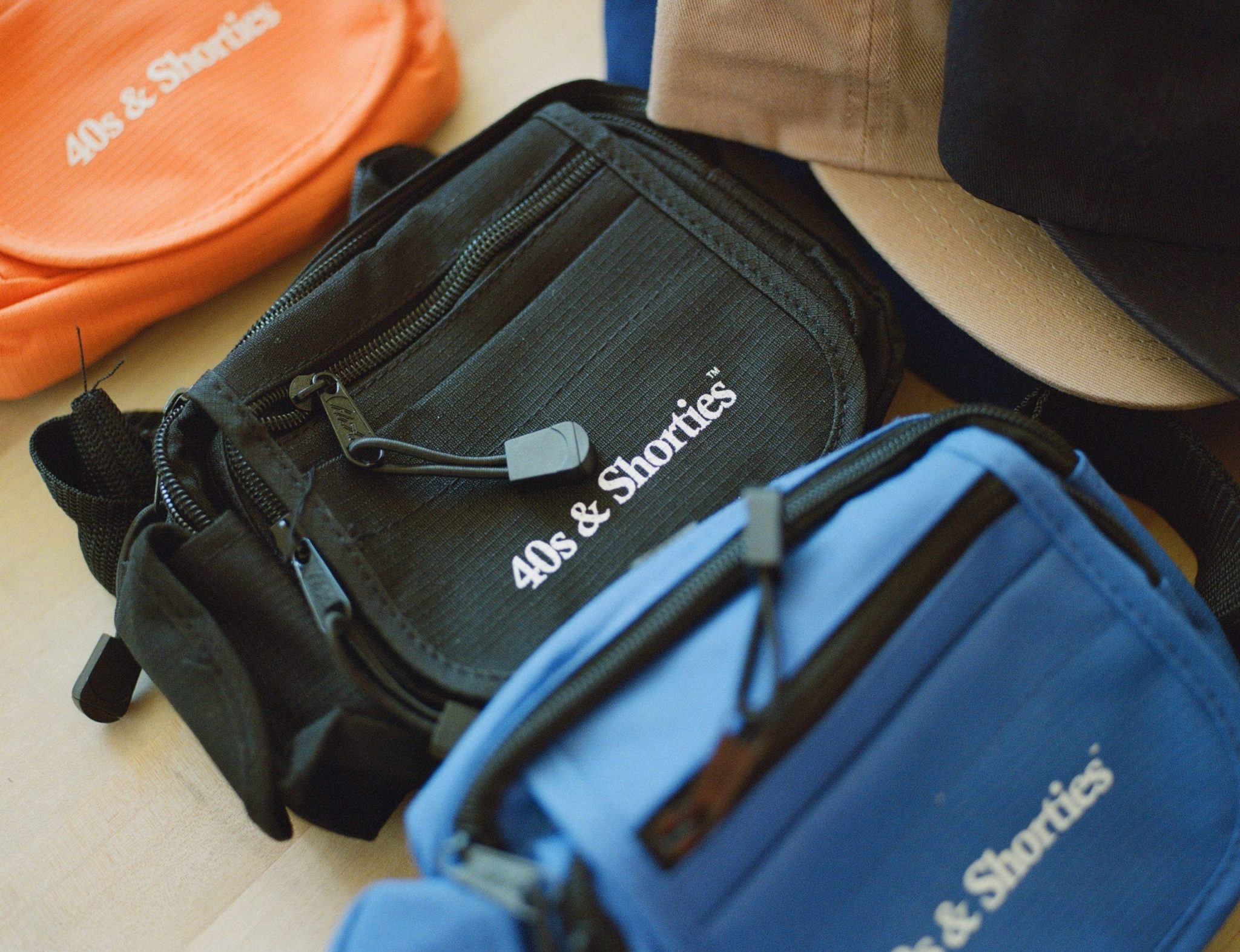
Some logo side packs and caps.
Charis: I spoke with Adem and Drew while the two of them were in Hong Kong for Art Basel holding a pop-up at a collaborative event called Club Haus that brought together various brands such as Carrots, Pleasures, Chinatown Market, and 40s & Shorties with local artists and music selectors.
Charis: Are you guys more globally minded now and is that a balance you have to strike between thinking for the American market and global? Or do you think they’re compatible in some way.
Drewbyrd: That’s a hard question for me, because I’ve been traveling for quite some time now. I feel like us being able to bring our West Coast culture and us being from the States and being born and raised from the Bay Area and California and now based in Los Angeles, I think it’s tight that we can bring it to world. We definitely have more of a global mind, but also I feel like people want to see where we’re from.
Adem: Absolutely. I think that’s actually…To answer your question, it’s difficult to do adequately right now because we’re in a transitional period within the history of our brand where that’s happening now. It’s like we come out the gate, we did this reference, this reference, this reference, straight up shit that we grew up on or just we gravitated towards for whatever reason it was. Then the first few seasons were in pretty direct relation to that.
But in the past and I’ll say like definitely for 2018, definitely 2017, there’s been an evolution or transition that’s been happening in the art, in the content, where it’s not just this stuff, right. Now we’re injecting our own personal style into the graphics and you’ve got to look at a lot of our graphics to understand that, but I think that the people that fuck with us, they know that and they get it. So what’s 40s and Shorties going to look like in 2020? It might not have a whole lot of West Coast, U.S. based references anymore. It might just be this style that we’re creating right now that’s just taken off.
Drewbyrd: Because up to this point that’s what we know of, being a U.S. brand from Los Angeles, California, but maybe in the next two years and stuff, like, we’ve been traveling as a brand more in the past year and a half now. So it’s only been a year and a half now, so I think we’ll definitely be evolving, you know, just with inspirations from coming to Hong Kong, Asia, Europe.
Adem: Absolutely. What I think is most important is for a brand to develop its own identity. It will always be influenced by the shit you grew up on. I think that always has the strongest ties in terms of creative directors banging out a collection, whatever sentiment that they have in —
Charis: Right, whatever resonates with you personally.
Adem: Exactly. That will happen in the beginning stages, but along the way you’re going to have your personal taste, your personal experiences, all those things evolve with you. The moment that you’re able to figure out it’s not so much a single graphic. We don’t got a show a low rider on a tee to be like, “Hey this is 40s and Shorties,” like nah. When you look at a graphic, just the feeling of it, the sentiment of it, it’s like, “Oh, that feels like 40s.” That’s kind of what we want to be eventually.
Charis: The way you guys started the inspiration comes from your specific lives and as you mature and see more of the world that’s naturally going to come through. Do you think that your fans are going to follow with you, like kind of grow in the same way, or are you attracting a different crowd?
Adem: I think both are happening and what’s really really awesome is to see the diehard people that fuck with us from the get go supporting that transition that’s happening all along the way.
Charis: When it comes to community — the people who have been with the brand since day one and the people who are newly hearing about them (perhaps from this story even) — Adem and Drew really care about everyone they’ve encountered through the brand.
Adem: I mean it sounds like some lame corny shit maybe but I fucking love the people that really are down for us. I mean, really fuck with you, that reach out to you on Instagram, that are fucking emailing you. You know you see it at a trade show; you see it at this event over here. I’ve lost count of the number of kids that I still text and I just keep up with going like, “Yo, when’s this coming out?” I love being able to learn from them, learn about their lives, and kind of grow the brand with them if that makes sense.
There’s this kid, I’ll give you an example. So one of the accounts we sell to in the U.S. is this store called Zumiez and there’s this kid named Devonte. He has bought product from us every single drop. He got my contact in Denver and I text him and he texts me once a week. He’s learning how to do graphics, right, so he wants my advice. I hit him back and I say, “Maybe tweak this. Maybe tweak this. You want to text me like an image of a new graphic that you’re working on. Why don’t you bang out maybe five and kind of craft it. Make sure it all works.” Devonte himself, as an example, is easily one of my favorite things about being in this industry.
Charis: Do you see yourself in a position to make lasting impact in people’s lives in a real way that’s more than about something that they wear? You know it’s not just about, “Oh I want you to buy this tee.” But you’ve described a perfect relationship where that’s happening.
Adem: Yeah, yeah, exactly. It’s like, man, dude, for the brand to make a lasting impact, that’s a very good question. I’ve no idea. I can’t say what 40s’ footprint is going to look like five years from now, if it’s still even happening. For us to make a lasting impression like one person by one person at a time is absolutely how I will contribute to that.
Drewbyrd: I think being able to impact especially the younger generation. For me personally, you can be someone who has no background in this, you know, and you can team up with some friends and just learn on the way. And if you can show them that if I can do that then you definitely can do that too. ‘Cause I didn’t know shit about this. It was honestly for me, it was just, like, if anyone’s trying to get into this and they have no background in it, they like it and they want to be involved in some sort of way, you can do it. Because for me it was just having good friends. That’s basically what it was for me.
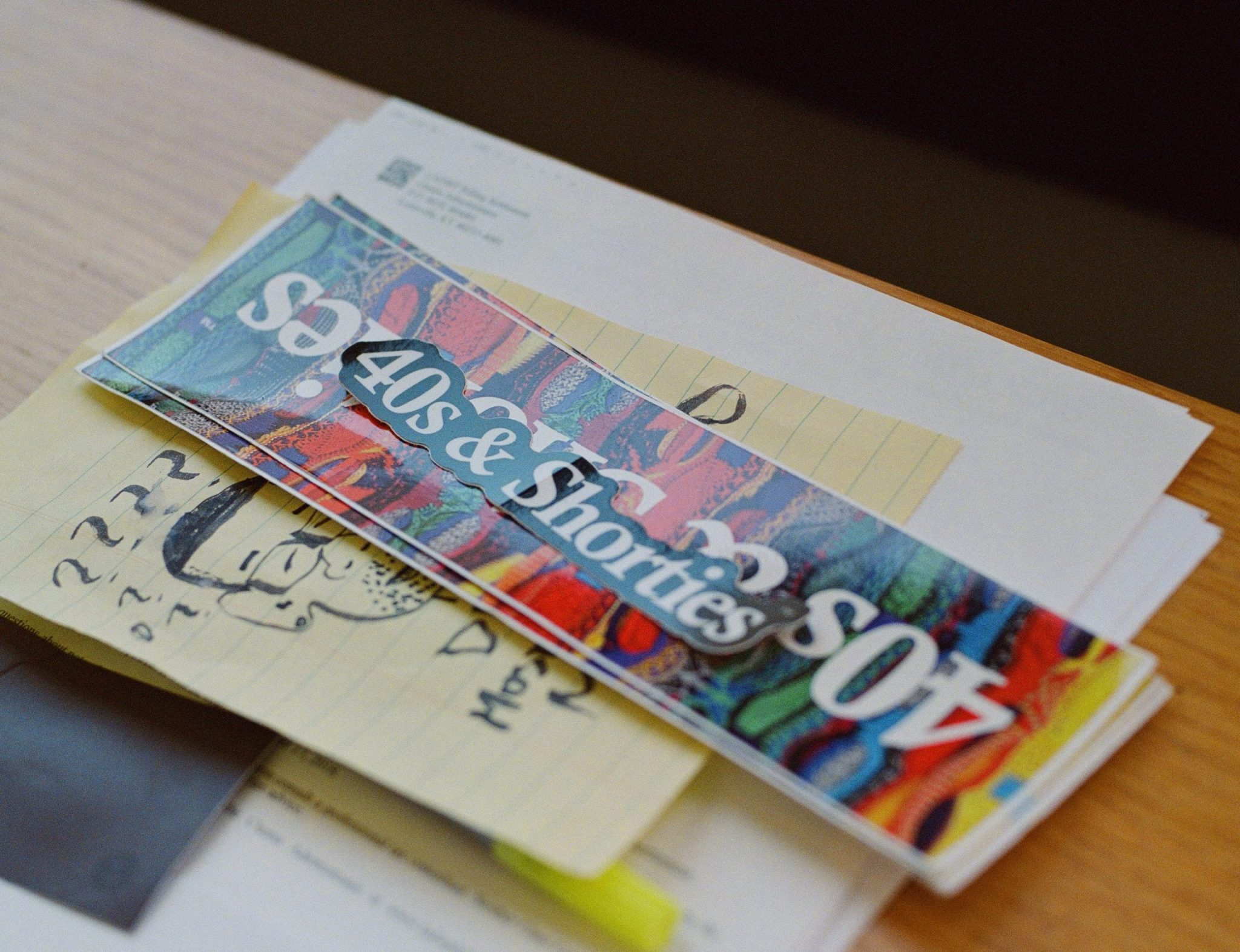
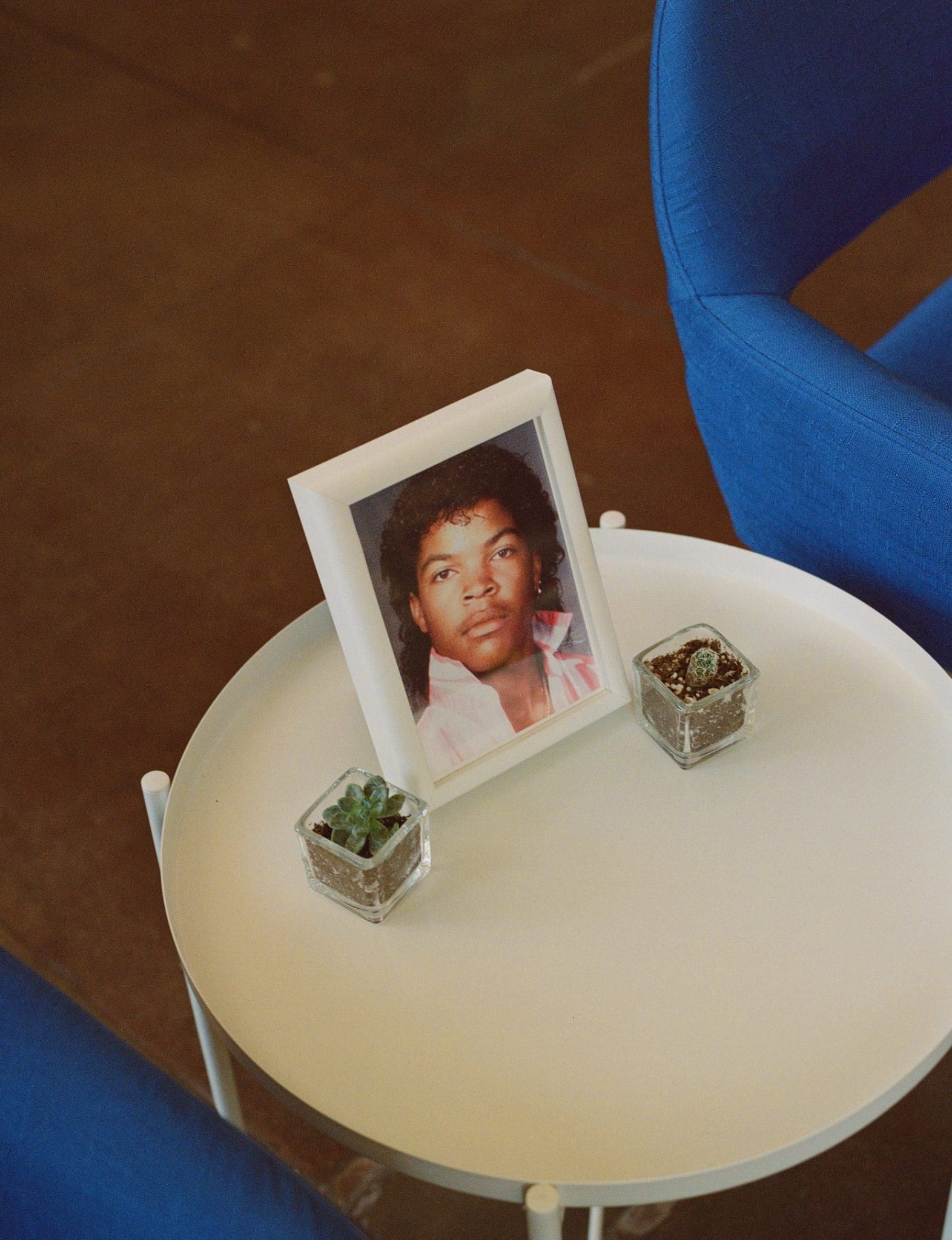
“For us to make a lasting impression one person by one person at a time is absolutely how I will contribute to that.”
— Adem Niazi speaking about the kind of lasting impact he wants 40s and Shorties to have.

Adem taking a look at designs for their upcoming drop.
Charis: Currently, even though outward appearances may suggest a much larger team, 40s and Shorties mainly consists of a tight core of three.
Charis: So what’s possible with three to four people and what’s not? You’ve clearly demonstrated that you can do a whole ton, right.
Adem: In this day and age with the resources that are basically literally at your fingertips with an iPhone or with a laptop a shit ton is possible. You have all the potential in the world, to answer your question. Then you have Instagram, you have Twitter, you have Snapchat. These are the new storefronts to the world.
Charis: Then there must be some things that you are hankering for, you want, and you know that you’re short-staffed. Resources are tapped.
Adem: Oh yes, absolutely. Absolutely. This guy is a fucking maniac. How he travels and consistently provides fucking content to our IG? He needs an intern.
Charis: I’m sure he does and I feel like there has to be a sacrifice that is being made here. There is something that is being given up.
Drewbyrd: 100 percent. I mean I just talked to Adem about this the other day. My days are literally cut in half now where it went from making beats all day and then playing at night to where it’s, like, I’m working on the brand with these guys during the day and then the second half of the day I’m working on music and other stuff I’m working on like DJing. So it’s definitely a lot of sacrifices for me. It’s all worth it, you know, because I still get to do music; I still get to play, but even so I get to travel to Hong Kong for Art Basel, do a pop-up for a brand I’m a part of and I still get to DJ at the same time.
Charis: I have a hypothetical question. Let’s say you got a cash infusion of a $150,000 USD. What would you do with that money? What would that mean for 40s to suddenly have that extra cash?
Adem: It’d fill in a lot of gaps.
Drewbyrd: Like help. That’s the first thing that pops into my head.
Charis: Hiring.
Drewbyrd: Yeah, hiring.
Adem: So to answer your question before.
Charis: About sacrifice.
Adem: The biggest sacrifice is time. Any sort of personal life that you think you’re going to have, you know, going into starting up a brand, granted that you’re really really putting in that real work. You give up a little bit of your personal life. You sacrifice time and when you’ve had just like a couple of years in the game you understand what’s truly truly important. Time, it’s not just money, time is, like, you can’t ever get it back. I have a daughter now, right, and so time that’s put into this brand is time away from her. And so that’s the sacrifice. That’s the clearest example I can give. That’s to answer your question. So to answer this question, if we had that extra money, it would immediately go to staff.
Charis: Let’s say you are working with people or you are hiring people, how do you know what people you want to work with? How do you identify that?
Adem: I think this guy’s a really good judge of character right off the bat. It’s not just like a resume. You can be really good on paper but it’s like if we don’t click with you —
Drewbyrd: Yeah, I think it’s just definitely got to click with us and also understanding what this hustle is about, you know what I mean. Especially for us where we’re at, right, we’re still very young, small and still growing so it’s not where it’s just, like, oh you come in and you’re just going to do this and peace out. It’s a real hustle. We’re not saying your whole life has to be around it. You’ve got to have some kind of work ethic still.
Adem: Information is so accessible nowadays. People are just hip with it. Outside looking in into this world you think it’s easy. You want the glitz and glam that comes with it but a lot of kids nowadays…Now again, I’m not shitting on all of them by any means. I’ve seen a lot of fucking real hustlers, really talented kids out there.
Drewbyrd: And this goes for our generation too.
Adem: Right, this goes for our generation as well. Absolutely. 100 percent. A lot of them aren’t willing to do what is required to get to this point. On a whole if I had one attribute that I would need in a business partner, an intern, whatever it is, is that drive, hunger. I’m talking to another intern right now. He doesn’t have all the experience in the world. He has a couple of tools in his belt, but easily what stands out the most is his drive. He honestly reminds me of me. When I first moved to L.A. I was so blind to any repercussions or any blowback just to fucking get on.
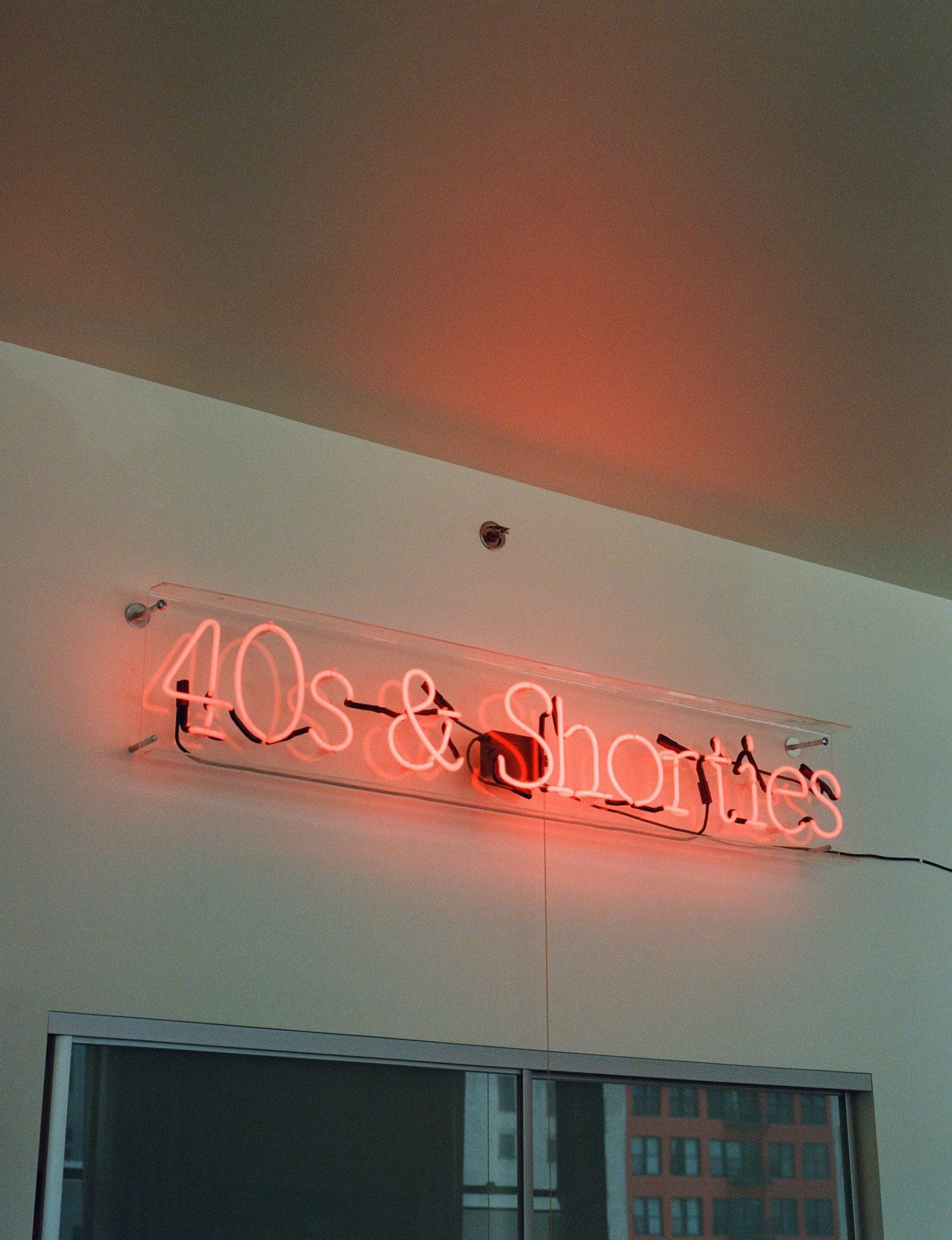

“For me personally, you can be someone who has no background in this and you can team up with some friends and just learn on the way. And you can show them that if I can do that then you definitely can do that too.”
— Drewbyrd on what his personal trajectory can show young people getting into the industry.

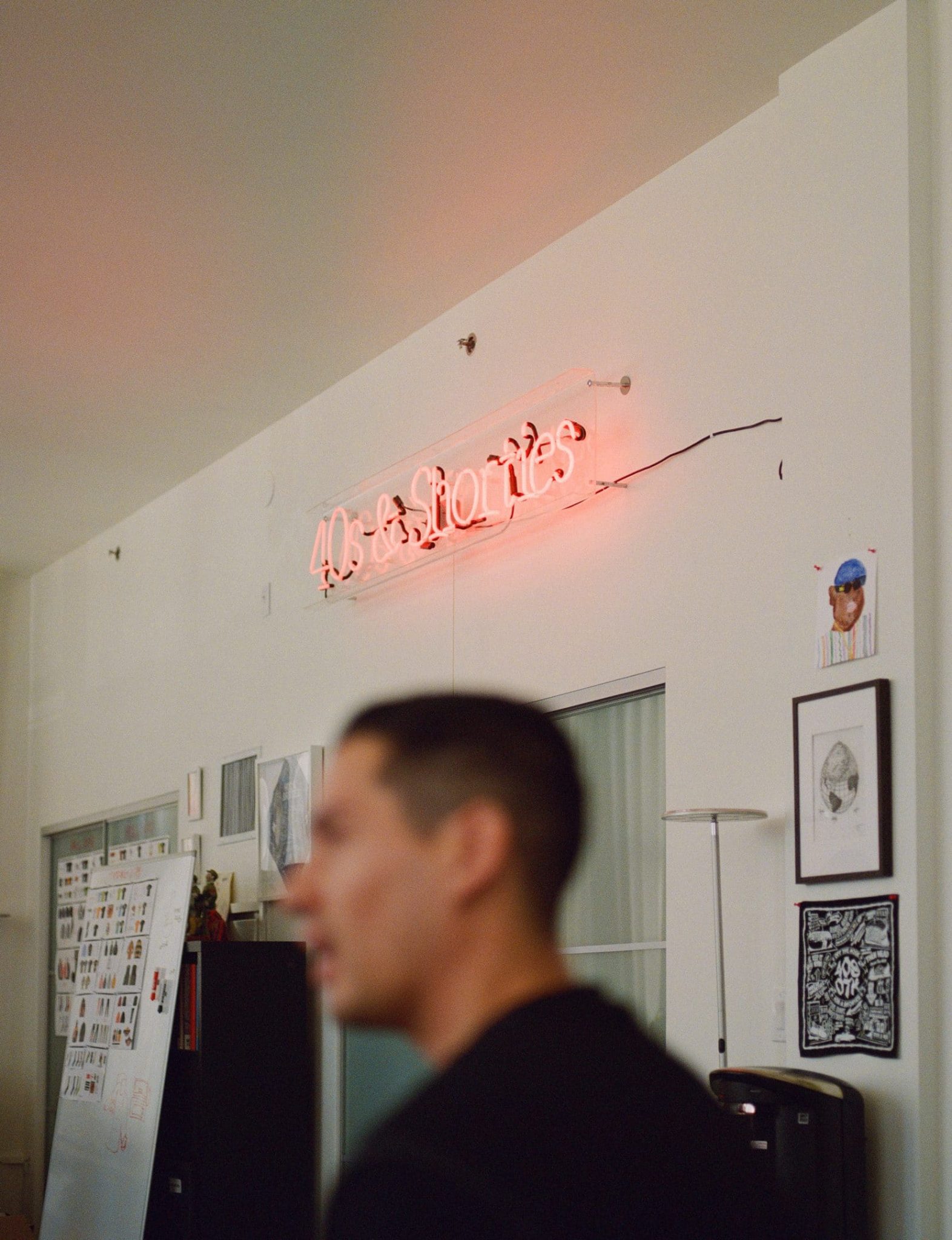
Charis: This is something I wanted to bring up. Clearly a lot goes into bringing a brand, like any brand, 40s included, to this level, right. And I feel like that’s not talked about a lot, like the actual nitty gritty of making it happen from design to getting the products done to putting it in stores. It appears to be so easy and laid back. As an industry do we need to talk more about what goes into it?
Drewbyrd: Definitely, you have to talk about it, you know, especially for younger cats that are like in high school or are 21, 22 trying to get into this game, so they know what we went through to get into it. But then also it’s just, like, also having a forward mind and knowing that, keep it honest, shit is different now. You can bang shit out easily and make a profit. I mean not everyone can do it. There is that possibility where you just come out with this graphic and it’s going to hit and you can just be on by that, you know.
This new generation in a way how social media is and how the Internet is where direct-to-consumer is so big where it’s just like you can do something quick and if you are very creative and it hits, that’s another way you can do it, you know.
So for me, I’ll be honest, I like the fact that I had to start where it’s like we had to put in so many hours and so much work to make it happen. But honestly, if I could do something where I could just put something on a tee or something and just get it out there easily and make it pop off like that, I would love that.
Adem: There shouldn’t be any sort of negative repercussions for what he just said. I think it depends on the brand and the person that’s driving that brand. You can have your one sort of graphic that some people might label as a sellout graphic or some shit like that, but it doesn’t outweigh what you were also doing over here. Both of those need to get acknowledged, absolutely.
Charis: I mean I’m not here to glorify hard work for hard work’s sake. I don’t want to fall into the trap that like, “Oh, we worked so hard and, like, give us props for working hard.” It’s not about that.
Adem: It needs to be discussed. People don’t discuss it, because nobody wants to hear about that shit. People just want to absorb the lifestyle that your brand’s supposed to be about. They want to see you popping bottles in the club and fucking you’re doing this or fucking with this person, all that shit. But a good way to sneak it in through the back door is like if you do an ill ass woven blanket for Art Basel you can talk about its execution and where it was developed and that’s how you talk in a way. You discuss how difficult it was to make this because it lets you know the value of what you’re about to buy.
Drewbyrd: And to add on top of that, because we’re on the subject, for me, coming back to my DJing background. When I was in high school I remember seeing older DJs, you know, that were in their mid 20s and even in their 30s that I somehow knew, criticize the music we listened to, you know, because they grew up more on, like, the Run-DMC era into the early Tribe era. For our era it was Cash Money Millionaires, No Limit Records. They criticized our music that we grew up listening to, even with Bay area rap culture it was different, you know. Me thinking back like that is like you don’t want to be that old head telling these young kids, “Yo, this ain’t right. This is not music.”
Because now look at it. When I play Big Tymers, you know, or any of that at a party it goes up. That’s what we grew up on and that’s our culture. So I’m just kind of like relating it to my experience as a DJ and hearing older cats telling me like, “Yo, this is not right. This isn’t right.” And for me when I see these young cats and they’re putting stuff on a T-shirt and stuff…As long, and here’s another side note too, as long as they know about the culture and kind of have some kind of understanding of the history of it and they respect it, they don’t have to talk about it —
Adem: As long as they respect it.
Drewbyrd: Yeah, so long as they respect it and then I’m like, “Yeah, go ahead do your thing,” because this is the way it’s going to move. It’s a new generation and let the kids do what they do.
Adem: It’s not about you don’t want to be like the old head. You need to understand and respect it for what it is. I take notice how easy certain brands are able to pop up and find success. At the same time, I’m like that is the tempo and the temperament of this generation coming up. Then you meet them later and they’re cool as fuck. And they’re like, “Yo, that thing you did is ill, like I know that reference.”
Drewbyrd: But also you can learn something from them, you know.
Adem: Absolutely. That’s the other big big thing is that you’re not Yoda just because you got years on them, right. That’s a really really good point. Learning how to adapt by seeing how they move is crucial.
Charis: I totally agree and I think it’s easier to just dismiss the kids and say, “Aw, we don’t need to pay attention to this.” What you’re suggesting, it takes more time for us to process this, like let’s think about why are they having success, where is their mind at.
“When people might not receive what you’re trying to do from the get go after all those hours that you put into it, it’s a little discouraging. But is it worth it? Fuck yes. Because it’s our way to tell our own story.”
— Adem Niazi
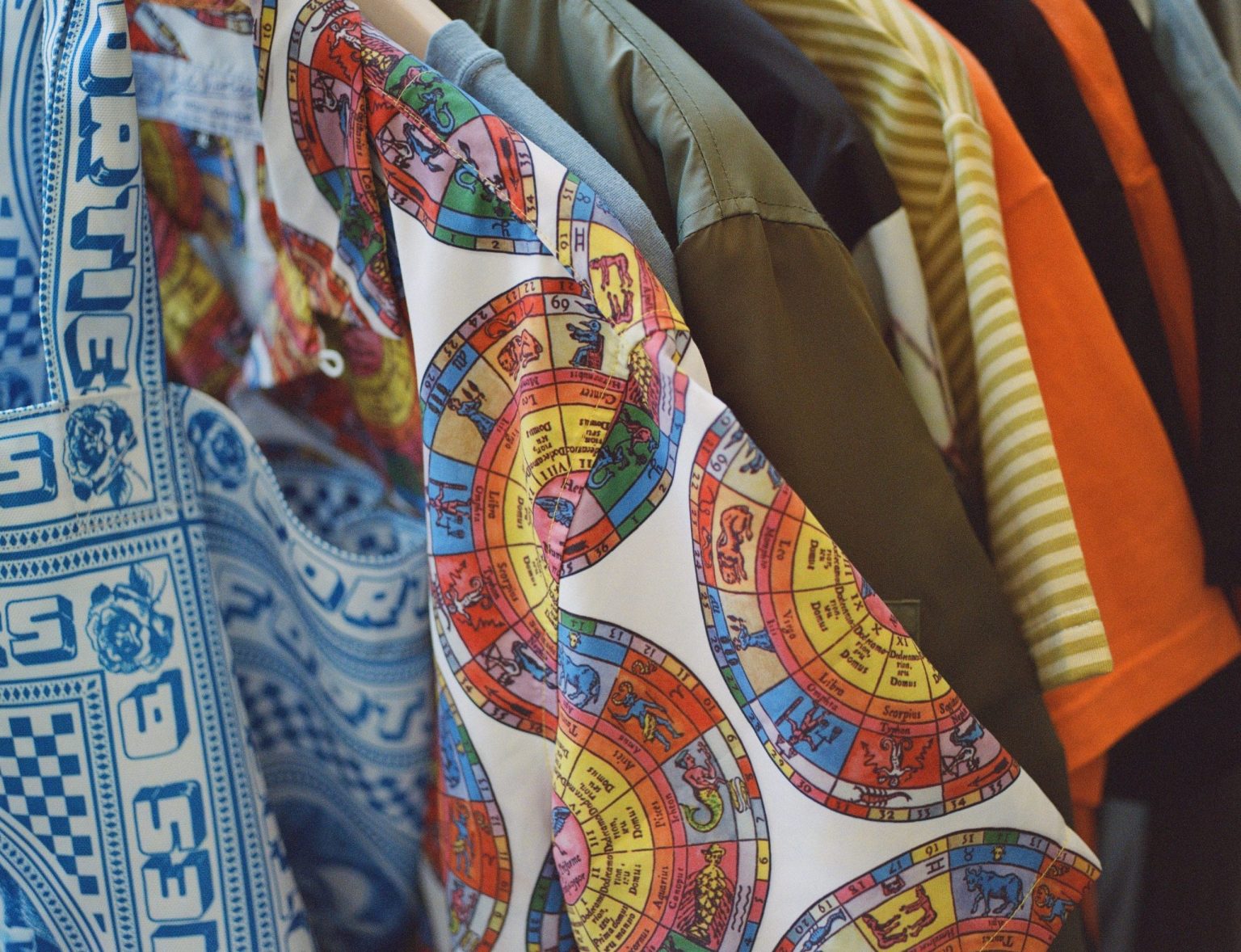
Charis: I asked Adem and Drew if there was anything from 40s and Shorties history that completely backfired on them. They first brought up the numerous cease and desists they’ve received from brands like Patagonia and Hennessy, but then Drew recalled a situation that definitely didn’t go the way they’d expected.
Drewbyrd: This is definitely one of them we’ll never do again. We’ll be more prepared. We did a one year anniversary party.
Adem: Oh my god. Yeah, yeah.
Drewbyrd: We did a one year anniversary house party in the Hollywood Hills in L.A. Basically the entire city came out.
Adem: This house got fucking destroyed.
Drewbyrd: Yeah we found it on Airbnb. We found a dude and he allowed us to book it through him without Airbnb to get, like, a cheaper rate or something. And he made us sign this little insurance thing or something hoping that it wouldn’t get fucked up and we’re like, “No, it’s only going to be, you know, 50 people max,” and stuff like that. And it’s a nice ass spot. And then our dumb asses didn’t think to move the nice ass furniture and stuff like that. We thought it was just going to be like brand owners and a couple of homies. But man, the word got out—
Adem: People fucking putting out cigarettes on the fucking white leather couches and shit. It was like, “Yo, turn up man, have a good time,” and everything like that, but that comes of our pocket. He had glass railing on the stairs. Glass got fucking cracked. When that shit gets cracked, you don’t just fix like that four-square inches that got cracked, you have to replace the whole fucking thing.
Drewbyrd: I just remember when it was not even midnight, it was like eleven thirty, all of us were like, “Bro, what the fuck.” And then the guy’s house he had an assistant and he was watching over the house and he was telling us, “You guys need to stop the party now! It’s going to be too crazy.” It’s overdone. The cops came too and all that stuff, but then he talked to cops and they left. He’s like, “Y’all just need to call the cops and kick everyone out because it’s getting too crazy.” I remember all of us just looking at each other like, “Fuck it, man.” This is one of these stories that you definitely learn from and you never ever — we’re going to definitely still do events and parties — but never like that again.
Charis: Talking about the efforts that they’ve put into organizing events lead to a discussion of the Art Basel pop up Adem and Drew had installed. The two of them had carried all of their set up materials over from LA — these materials included Virgin Mary candles, vinyl wrap for the floor and walls, the woven blankets and tote bags that were being sold, and even a small wooden pew with red velvet draping.
Adem: The booth is essentially…It’s meant to be modeled after the interior of a church. The idea is that…I’m sorry for people who don’t know the product or haven’t seen it yet, it’s an original graphic that’s inspired by sort of East L.A. cholo style art, but then dead center in the art is actually an etching piece of the Virgin Mary. The Virgin Mary has these DIY collage eyes that are kind of seductive and suggestive.
That idea of having, like, say, the Virgin Mary that’s housed in the social conformity of “this is good, this is bad” being poked fun at — that’s 40s and Shorties to me. Overall the commentary essentially is meant to be that the pace in the current climate of fashion and I would say hype in general has become the new religion. That your followers or your fans or your customers pray to their respective religion.
Charis: 40s puts this much effort into every event, booth and pop-up, whether at Hong Kong Art Basel or for Hustler or at Complex Con.
Adem:When people might not receive what you’re trying to do from the get go after all those hours that you put into it, it’s a little discouraging. But is it worth it? Fuck yes. Because it’s our way to tell our own story.
Charis: In spring 2017, 40s and Shorties collaborated with Sam’s Hofbrau, a gentlemen’s club in L.A. And then towards the end of the year, 40s released a collection with Hustler, the monthly pornographic magazine first published in 1974 by Larry Flynt. I wanted to hear some more about the thinking behind these two collaborations to see how they fit in with the 40s identity.
Charis: You guys collaborated with Hustler and you also collaborated with Sam’s Hofbrau. I was wondering if doing those kind of collaborations is more tricky nowadays after kind of this #MeToo women’s rights movement. There’s more potential for backlash.
Drewbyrd: Yeah, for sure. For me specifically, Sam’s Hofbrau is an L.A. staple. Sam’s Hofbrau was more of a nostalgic thing because 40s and Shorties is definitely based on nostalgia and stuff. Everyone in L.A. knows what Sam’s Hofbrau is.
Adem: I mean it could just as easily have been a bar. It just happens to be this L.A. staple.
Charis: What it is though to me, it’s a bit of a gamble. Because obviously there is going to be a portion of your audience who’s going to understand that, who’s going to appreciate that and think this is great, but there’s definitely a portion of people out there who are just going to —
Adem: Just another brand doing some, you know —
Charis: That’s the thing that you have to factor in, right.
Drewbyrd: And Adem knows, I voiced my opinion on this a lot. For Adem, he’s the one who brought Hustler to the table and I told him like, “Yo, we’re doing too much of this hardcore, you know, like, sex type stuff,” but his explanation was the story of Larry Flynt.
Adem: How I saw the collaboration come to life with Hustler wasn’t so much focused on naked girls in a magazine. It’s not about that. The story of Larry Flynt is actually one that’s just really really interesting and a real American rags to riches kind of story. And in a way I thought it actually paralleled what we’re trying to do with 40s, like how we founded ourselves, like you have to put in that work to establish yourself, like all that, there were parallels.
Plus, with the Hustler thing there was a lot of political activism that actually went into that. His defense of his first amendment rights, his freedom of speech when he was being isolated and separated from all of these other adult publications. Why am I being singled out? I have the right to publish this sort of content the same way that Playboy does over here, all these other literally 68 other publications that exist in the state of Ohio alone. Why am I being singled out? So I kept this story in mind as I was building out the capsule and I didn’t really want to focus on the raunchy aspect so much. If you take a close look at the final capsule, it’s actually Larry Flynt heavy.
So regardless of whatever your opinion is, as long as you’re receiving and delivering it with respect, we’ll be okay, we can have a healthy discussion about that shit.
If we were ever worried about some sort of being boxed in this idea of only doing grimy raunchy shit or whatever, it’s balanced out by equally dope stuff too. That is the complete opposite end of that spectrum too with just as well thought out product.
“I get a reminder I’m like, damn, I’m really working with my friends and we’re traveling and we have our own office. We make our own schedules.”
— Drewbyrd speaking about the times it occurs to him how few people might successfully create a lifestyle like the one he has.
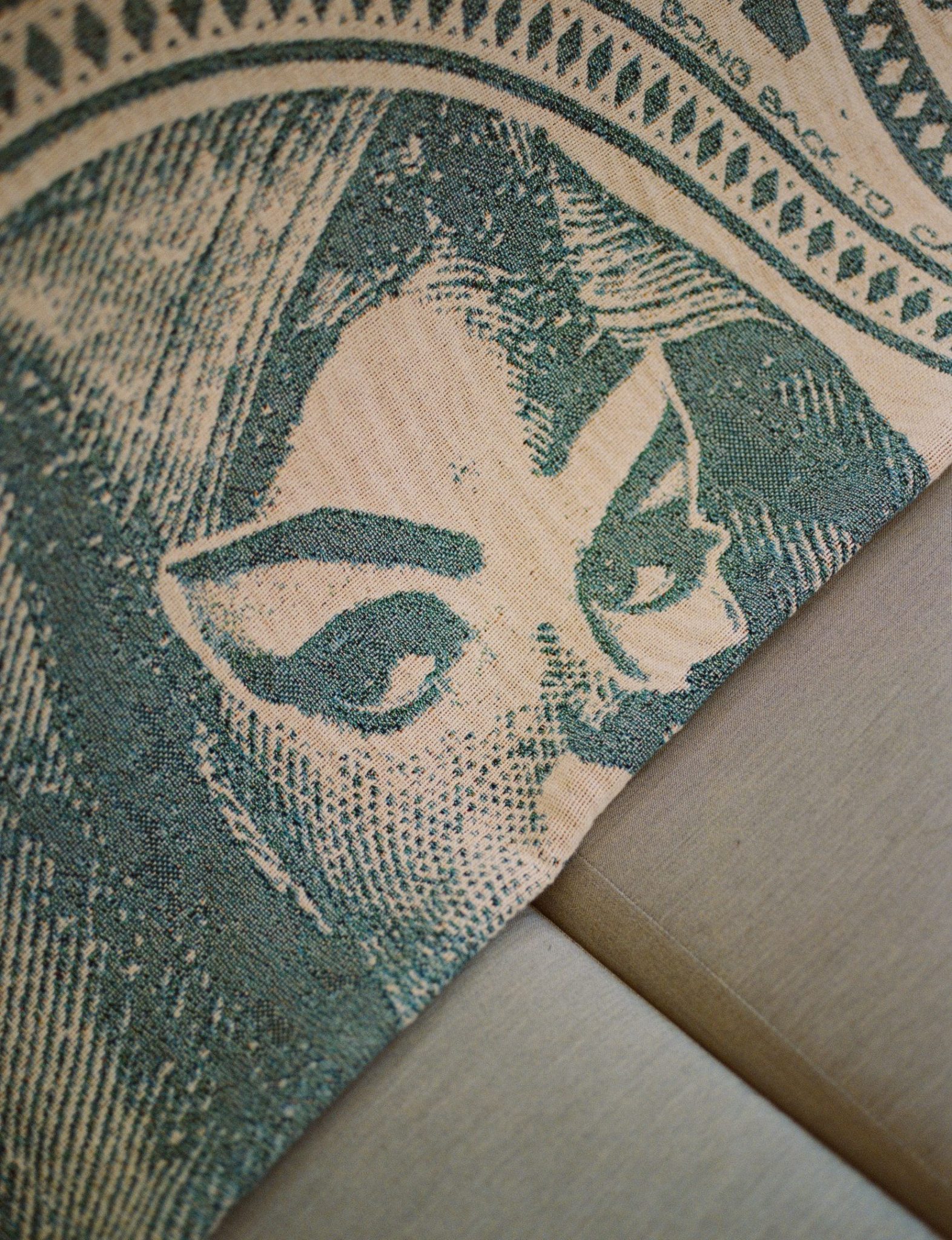
The Virgin Mary with DIY collage eyes on the woven blanket created for Art Basel Hong Kong.

Charis: Adem spoke about not picturing 40s and Shorties in any kind of box, even if outsiders might see the brand that way. But it’s not possible to exist in a vacuum.
Charis: Do you guys think of your brand in relationship to your favorites? Like do you think about how are we positioned compared to them or is it we do our own thing and even though this is my personal favorite, it’s existing somewhere else.
Adem: The artistic temperament response would be like, “Fuck it, man, you know, we do our own thing,” and we’ve got blinders on, but if any thinking person says that they’re lying at least a little bit because to do that entirely 100 percent is, in a way, slightly foolish. You have to understand what’s at least in your peripherals, because you know this person over here just did this design for instance. Do you want to have blinders on to do that same design?
And I know I’m about to contradict myself — I’ve actually done that to a degree, but it wasn’t deliberate necessarily. If you understand the development calendar you have to do stuff at least six to eight months in advance, right, so if that graphic, wherever the fuck it is, it’s already in development and you see these motherfuckers over here drop it before you, you’re like, “Fuck that shit, we’re still going to run it ‘cause I like ours.” That’s almost like a logistical example of it. In terms of an artistic context to answering that, yeah, I want to be as dope as this brand over here. I would love to have 40s be received, not in the same vein, but with the same respect as Sacai over here.
Charis: There’s still something that’s aspirational for you guys.
Adem: Absolutely and it goes back to one of the earlier questions that you asked. It’s like that young broad driving force that sort of fueled 40s in the first two seasons that has me still going now and it’s me as a fan of this culture, me still looking up to other brands and aspiring to be as ill as them. Like Junya! Just genius.
There’s no compromise. It’s so insane, like 900 different panels and fabrics and textures, but all of it compositionally works together beautifully. To me there’s not a compromise. That’s what I would like for 40s. We’re gonna do what we want to do. Okay, we understand you have to compromise to a degree, it’s a business as well. But that’s how I’d like to parallel our brand with another brand, aspirational.
Charis: It’s not about the specific thing that that brand is producing, but it’s that mentality you also want to have.
Adem: Yes, yeah.
Charis: Well-thought out products, a refusal to compromise, those things resonate widely with entrepreneurs and business owners — another thing about the 40s and Shorties ethos that is even more universal is the joy of working with friends.
Charis: One thing I identified with myself, like resonated with me, about 40s and Shorties is getting to work with your friends and build a thing. I was wondering if you guys have that feeling sometimes like, “Oh my goodness, couple years down the road I’m still just working with friends, working hard, but I get to make this thing real.”
Drewbyrd: I think definitely. I think yesterday we were at a dinner. It was us, and Mike Cherman from Chinatown Market, Vlad and Alex from Pleasures, Carlos and a few people from L.A. And I was talking with Vlad and we stepped outside and we were talking and we just had the same conversation. Putting into quotes what Vlad said to me when we were talking about it, “Yo, we’re like the five percenters of just people who could work with your friends and meet other friends in different countries, do special projects like this. We kind of carve our own path.”
Sometimes you take it for granted, though, you know, because, like, he knows my complaints. It’s like fuck, I got to go here. I don’t want to go here. Got to go out here to shoot this thing in a different city it’s like, “Fuck, why do I gotta do that.” But you got to keep in mind, man, my mother she works in a factory, you know. So yes, definitely I still, once in a while, I get a reminder I’m like, damn, I’m really working with my friends and we’re traveling and we have our own office. We make our own schedules.
Adem: A lot of times you get sucked into the void of just the hustle. When you got to do everything yourselves it sucks up a lot of time and you’re just drawn into it. Sometimes you got to step back or sometimes you’re fortunate to have that step being taken back for you when you get to go on a trip like this. And you get to travel the world, you get to meet other homies that are like-minded that you get to share creative ideas with. Then, shit, you’re like, “Holy fuck, this is amazing.”
Charis: This story was hosted, narrated, and written by myself, Charis Poon. Audio was mixed by Elphick Wo. The rest of the team includes Eugene Kan, Alex Maeland, and Nate Kan. Listen to the full audio story above to hear the excerpt at the end when Drewbyrd shares what he thinks is highly underrated. Click play below to hear a curated selection of songs from 40s and Shorties.
Ha by Juvenile
The Start of Your Ending by Mobb Deep
Two Dope Boyz (In a Cadillac) by Outkast
Pac Div by Pac Div
Grindin’ by Clipse
93 ’til Infinity by Souls of Mischief
Flamboyant by Big L
Last Call by Kanye West
Too Hard for the Radio by Mac Dre
Players Holiday (feat. Too $hort & Mac Mall) by TWDY
